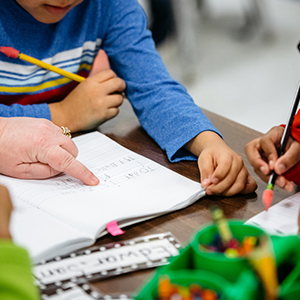 As the end of summer break draws near, it can cause increased student stress and anxiety. The upcoming changes in routine, academic pressure, and social dynamics that come with starting a new school year can create unease and anticipation for students during this transition period.
As the end of summer break draws near, it can cause increased student stress and anxiety. The upcoming changes in routine, academic pressure, and social dynamics that come with starting a new school year can create unease and anticipation for students during this transition period.
The UAB communications team interviewed Maggie Canter, Ph.D., an assistant professor in the Department of Psychiatry and Behavioral Neurobiology, to share valuable tips to help reduce the stress associated with the back-to-school period.
Adjust sleep schedules
Getting kids back on a regular sleep schedule can help reduce stress before they return to school. They commonly stay up late and sleep in during summer, but they need time to adjust to their regular school hours before school starts.
“Parents can do this by gradually changing their bedtime by 15 minutes each night and waking them up within an hour of their school wake-up time”, Canter said.
Parents should also be mindful of how their discussions about the return to school can profoundly influence children's emotions and success. Engage in conversations about the positive aspects they anticipate and show belief in their capabilities for the upcoming school year.
Create daily schedules
Creating daily schedules can significantly benefit children juggling responsibilities like school, extracurricular activities, part-time jobs, and chores. It's challenging for them to keep up with everything and get enough sleep.
“By scheduling different subjects, activities, and social outings, children can feel less overwhelmed and learn to prioritize tasks effectively (e.g., homework before video games),” Canter said. “Also, breaking tasks into smaller parts and scheduling short breaks can improve focus, reduce anxiety, and make tasks more manageable.
Relaxation exercises
Canter shared her two preferred relaxation exercises for achieving a state of calm and promoting relaxation. The first exercise centers around practicing slow, deep breaths, countering short and shallow breaths that often arise when upset or anxious.
She advises counting breaths for a minute and gradually reducing the count, aiming to breathe in for at least 4 seconds and exhale for 6 seconds. To engage preschoolers in enjoyable activities, Canter suggests smelling flowers, blowing out birthday candles, or pretending to blow bubbles.
The second exercise, called "My Favorite Place," is a technique that involves visualizing oneself in a content and secure location, whether real or imaginary. For example, children can imagine being at the beach, in their bedroom, at a mall food court, in a mythical candy land, on a cloud, or at Disney World.
By closing their eyes and activating their senses, they can explore the vivid details of that place, including what they see, hear, smell, taste, and touch. Upon completing the exercise, children can return to their tasks calmly, as if they had experienced a brief rejuvenating vacation.
Classroom environments matter
Effective communication among teachers, parents, and students is vital in helping children transition smoothly into a new school year. Informing them about what to expect can make them more comfortable.
“Teachers can have a trial period for rules and expectations before enforcing them strictly, allowing children to learn and adjust their behaviors positively,” Canter said. “It's also essential to communicate directly with parents, as not all children effectively convey messages to their parents.”
By informing parents about classroom expectations, they can better support their children in meeting them. Additionally, validating children's anxiety and assuring them that it's normal to feel nervous at the beginning of the school year can help ease their worries. Building a relationship and getting to know each other takes time.